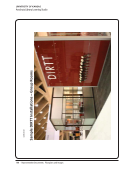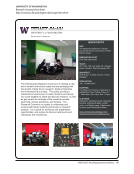208 · Selected Resources: Books and Journal Articles
Kilzer, Rebekah. “Reference as Service, Reference as Place: A View of Reference in the Academic Library.”
The Reference Librarian 52, no. 4 (2011): 291–99.
King, Helen. The Academic Library in the 21st Century—What Need for a Physical Place? http://educate.lib.
chalmers.se/iatul/proceedcontents/qutpap/ king_full.html.
Kratz, Charles. “Transforming the Delivery of Service: The Joint-Use Library and Information Commons.”
College &Research Libraries News 64, no. 2 (2003): 100–1.
Kvenild, Cassandra, and Kaijsa Calkins. Embedded Librarians: Moving Beyond One-Shot Instruction. Chicago:
Association of College and Research Libraries, 2011.
Lachance, Janice. “Changing Our Own Behavior.” Information Outlook 15, no. 4 (2011): 3–4.
Lawrence, Deirdre. “New York Art Resources Consortium: A Model for Collaboration.” Art Documentation
28, no. 2 (2009): 61–3.
Lee, Dale, Diane Klare, Pat Tully. “Not Exactly Trading Spaces: The Wesleyan University Library Information
Commons [Nercomp, June 5, 2007].” DigitalCommons@Providence, http://digitalcommons.providence.
edu/lib_publications/16.
Lee, Marta, Jon Ritterbush, and Robert Sivigny. “Reference at the Commons: A Case Study.” Reference Services
Review 38, no. 1 (2010): 81–89.
Leighton, Philip D., David C. Weber, and Keyes DeWitt Metcalf. Planning Academic and Research Library
Buildings. Chicago: American Library Association, 1986.
Lessin, Barton. “Merging Science/Technology Libraries.” Science &Technology Libraries 21, no. 1/2 (2001): 3–16.
Lewis, Vivian, Cathy Moulder. Graduate Student and Faculty Spaces and Services, SPEC Kit 308. Washington,
DC: Association of Research Libraries, 2008.
Lincoln, Yvonna S., Vicente M. Lechuga. Research Libraries as Knowledge Producers: A Shifting Context for Policy
and Funding. Final Technical Report to the Task Force on New Ways of Measuring Collections, Association of
Research Libraries, 2006.
Lippincott, Joan. “Information Commons: Meeting Millennials’ Needs.” Journal of Library Administration 50,
no. 1 (2010): 27–37.
———. “A Mobile Future for Academic Libraries.” Reference Services Review 38, no. 2 (2010): 205–13.
———. “New Library Facilities: Opportunities for Collaboration.” Resource Sharing and Information Networks
17, no. 1/2 (2004): 147–57.
Liu, Guoying. “The Application of Intelligent Agents in Libraries: A Survey.” Program 45, no. 1 (2011): 78–97.
Lougee, Wendy Pradt. Diffuse Libraries: Emergent Roles for the Research Library in the Digital Age. Washington,
DC: Council on Library and Information Resources, 2002.
Lowry, Charles. “Year 2 of The “Great Recession”: Surviving the Present by Building the Future.” Journal of
Library Administration 51, no. 1 (2011): 37–53.
Kilzer, Rebekah. “Reference as Service, Reference as Place: A View of Reference in the Academic Library.”
The Reference Librarian 52, no. 4 (2011): 291–99.
King, Helen. The Academic Library in the 21st Century—What Need for a Physical Place? http://educate.lib.
chalmers.se/iatul/proceedcontents/qutpap/ king_full.html.
Kratz, Charles. “Transforming the Delivery of Service: The Joint-Use Library and Information Commons.”
College &Research Libraries News 64, no. 2 (2003): 100–1.
Kvenild, Cassandra, and Kaijsa Calkins. Embedded Librarians: Moving Beyond One-Shot Instruction. Chicago:
Association of College and Research Libraries, 2011.
Lachance, Janice. “Changing Our Own Behavior.” Information Outlook 15, no. 4 (2011): 3–4.
Lawrence, Deirdre. “New York Art Resources Consortium: A Model for Collaboration.” Art Documentation
28, no. 2 (2009): 61–3.
Lee, Dale, Diane Klare, Pat Tully. “Not Exactly Trading Spaces: The Wesleyan University Library Information
Commons [Nercomp, June 5, 2007].” DigitalCommons@Providence, http://digitalcommons.providence.
edu/lib_publications/16.
Lee, Marta, Jon Ritterbush, and Robert Sivigny. “Reference at the Commons: A Case Study.” Reference Services
Review 38, no. 1 (2010): 81–89.
Leighton, Philip D., David C. Weber, and Keyes DeWitt Metcalf. Planning Academic and Research Library
Buildings. Chicago: American Library Association, 1986.
Lessin, Barton. “Merging Science/Technology Libraries.” Science &Technology Libraries 21, no. 1/2 (2001): 3–16.
Lewis, Vivian, Cathy Moulder. Graduate Student and Faculty Spaces and Services, SPEC Kit 308. Washington,
DC: Association of Research Libraries, 2008.
Lincoln, Yvonna S., Vicente M. Lechuga. Research Libraries as Knowledge Producers: A Shifting Context for Policy
and Funding. Final Technical Report to the Task Force on New Ways of Measuring Collections, Association of
Research Libraries, 2006.
Lippincott, Joan. “Information Commons: Meeting Millennials’ Needs.” Journal of Library Administration 50,
no. 1 (2010): 27–37.
———. “A Mobile Future for Academic Libraries.” Reference Services Review 38, no. 2 (2010): 205–13.
———. “New Library Facilities: Opportunities for Collaboration.” Resource Sharing and Information Networks
17, no. 1/2 (2004): 147–57.
Liu, Guoying. “The Application of Intelligent Agents in Libraries: A Survey.” Program 45, no. 1 (2011): 78–97.
Lougee, Wendy Pradt. Diffuse Libraries: Emergent Roles for the Research Library in the Digital Age. Washington,
DC: Council on Library and Information Resources, 2002.
Lowry, Charles. “Year 2 of The “Great Recession”: Surviving the Present by Building the Future.” Journal of
Library Administration 51, no. 1 (2011): 37–53.






















































































































































































































